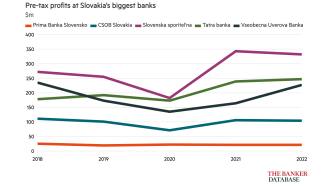The Banker’s second listing of the Top 100 banks in the 27 EBRD transition countries is again dominated by Russian banks with the two state-owned giants, Sberbank and Vneshtorgbank, heading the list. Overall there are 30 Russian banks in the Top 100, reflecting the continued resurgence of the banking sector there based on a buoyant economy. The next largest grouping is provided by Poland (15) followed by Hungary (11). The category ‘Others’ comprises banks from Ukraine (3), Serbia and Montenegro (3), Belarus, Bulgaria and Latvia (2 each), and Lithuania (1). As last year, 17 out of the 27 transition countries are represented in the listing.
Overall, Tier 1 capital for the Top 100 rose 25% to $45bn from last year’s $36bn, largely through real increases in bank capitalisation but in part due to the weakening dollar. The Russian banks provide 34.7% of the aggregate capital while Polish banks account for 20.1%. The Czech Republic, with only six representatives in the Top 100, claims 11.7% of the aggregate capital while Hungary’s 11 banks provide 8.8%.

This strengthening of the Czech banks’ capital base is evident in the listing, where Ceskoslovenská obchodní banka (CSOB) has moved up from fifth place to third, Ceská Sporitelna from tenth to sixth and Komercní banka has moved into the top 10 at nine. The remainder of the Top 10 is made up of the four major Polish banks, Pekao (at 4), Handlowy (5), PKO (7) and Przemyslowo-Handlowy PBK (8), and the Swedbank-owned Estonia-headquartered banking group, Hansabank (10). This latter group, which has major subsidiaries in Latvia and Lithuania, last month expanded into Russia with its acquisition of Kvest bank.
Foreign influence
In this year’s listing 47 of the 100 are majority-owned or wholly owned by foreign financial institutions including 11 of the top 20. This trend is likely to continue with banks such as Raiffeisen Zentralbank Österreich (RZB) actively seeking to expand further into central and eastern Europe. Most of the transition countries have made progress in rationalising their banking systems but three countries are arguably still overbanked: Russia, Ukraine and Serbia and Montenegro. The introduction of the deposit insurance system in Russia, for which 1140 banks (out of 1277) have applied to be members, will provide a further impetus to the process of weeding out the weak and undercapitalised. Ukraine still has some 150 banks operating, many of which are small and poorly capitalised. A lack of transparency in bank ownership is a potential bar to raising additional capital for a number of banks.
Serbia with 47 banks and Montenegro with 10 are overbanked. Serbia has plans for the disposal of the government’s holdings in several banks. Confidence in the sector is growing and capitalisation is improving as witnessed by the fact that three Serbian banks make this year’s list, against one last year.
With the accession of eight transition countries to the EU last May, and Romania and Bulgaria on track to join them, the question is how much longer will these countries be regarded as in ‘transition’? In fact, the Czech Republic has recently announced its intention to ‘graduate’ from borrower status with the World Bank – being a recipient of its financial and technical assistance – to being an important partner and provider of development assistance.











